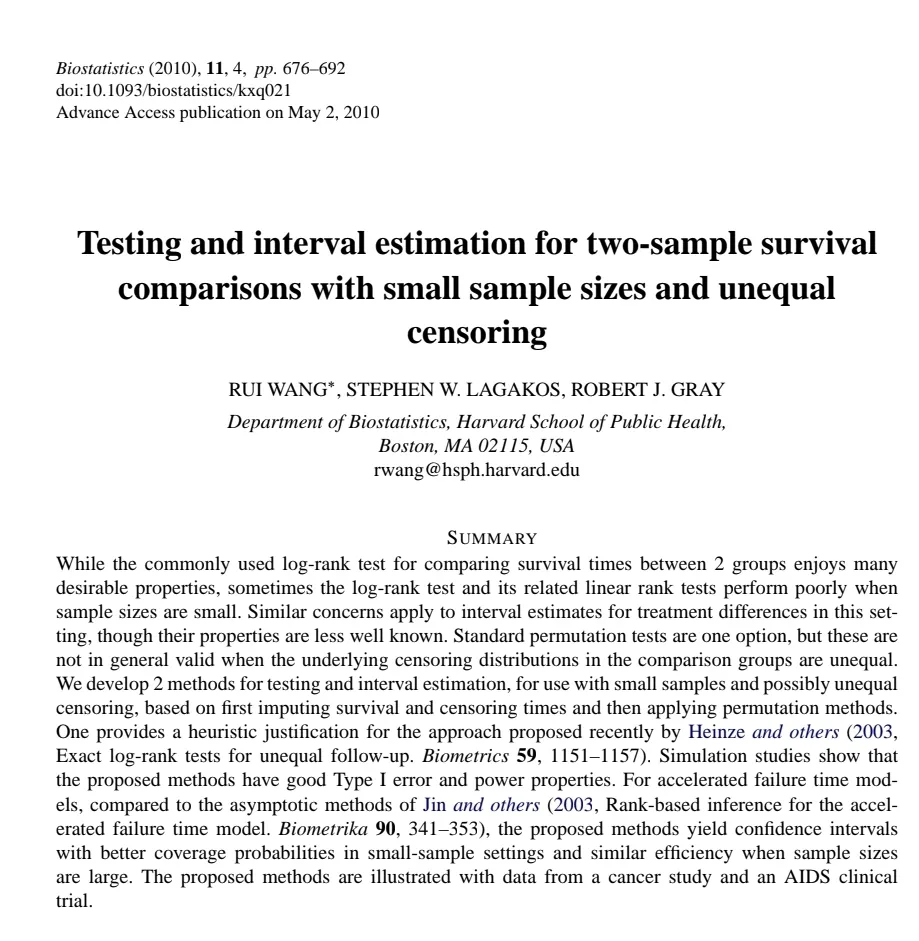
Exploring New Imputation and Permutation Methods to Improve Statistical Validity in Clinical Trials
The article “Testing and interval estimation for two-sample survival comparisons with small sample sizes and unequal censoring” by Rui Wang, Stephen W. Lagakos, and Robert J. Gray, published in Biostatistics, presents innovative methodologies aimed at addressing significant challenges in survival analysis, particularly when dealing with small sample sizes and unequal censoring. This blog will provide a comprehensive exploration of the article’s methodologies, findings, and implications for biostatisticians and clinicians, incorporating key equations to illustrate the concepts discussed.

Survival analysis is a statistical method used to analyze time-to-event data, which is critical in clinical trials for comparing treatment effects. The log-rank test is the standard approach for this purpose. While it has many desirable properties — such as being computationally simple and asymptotically valid — it tends to perform poorly under certain conditions, particularly when sample sizes are small or when the censoring distributions differ between groups. Censoring occurs when the event of interest is not observed for all subjects, leading to incomplete data.
The authors emphasize that traditional tests like the log-rank test can yield inaccurate results under specific conditions:
Previous attempts to refine these tests have had limited success. Standard permutation tests are generally valid only when the censoring distributions are equal. When they differ, especially in small samples or with substantial censoring, these tests may fail to maintain appropriate Type I error rates (the probability of incorrectly rejecting a true null hypothesis) and power (the ability to correctly reject a false null hypothesis).
Wang et al. propose a two-step approach that involves imputation followed by permutation testing:
Permutation Tests: After imputation, permutation methods are applied to test hypotheses regarding the survival distributions of the two groups. The authors develop two types of permutation tests:
Traditional Permutation Test: This method assumes equal censoring distributions between groups and permutes group membership while keeping survival times fixed.
Modified Permutation Test: This test is motivated by hypothetical scenarios where both survival times and censoring times are known. It leverages the independence of survival and censoring times within each group.
The authors define their hypothesis testing framework as follows:
For group j:Vij=(U~ij,δ~ij)
where U~ij=Ui if Zi=j
Sample from Fj if Zi≠j
For group j:where Vij=(U~ij,δ~ij)
U~ij={Ui Sample from Fj if Zi=j if Zi=j
This construction ensures that the new observations are independent of group membership under H0.
The article includes extensive simulation studies comparing the performance of their proposed methods against traditional log-rank tests and existing permutation tests. Results indicate that the new methods maintain appropriate Type I error rates and exhibit superior power in small-sample settings with unequal censoring.
The authors also focus on developing confidence intervals for parameters in accelerated failure time (AFT) models. Traditional methods often rely on large-sample approximations that may not hold in small samples. By inverting their proposed imputation/permutation tests, they provide confidence intervals that perform well even with limited data.
CI=[θ^−zα/2SE(θ^),θ^+zα/2SE(θ^)]CI=[θ^−zα/2SE(θ^),θ^+zα/2SE(θ^)]
where zα/2zα/2 is the critical value from the standard normal distribution corresponding to a significance level αα, and SE(θ^)SE(θ^) is the standard error of the estimate.
The authors provide a detailed framework for hypothesis testing under their proposed methodologies:
The article emphasizes theoretical underpinnings by providing mathematical justifications for their methodologies:
Biostatisticians can leverage these new methodologies to improve the accuracy of survival analyses in clinical trials where sample sizes are limited or where there is significant censoring. The imputation techniques allow for more robust analyses by systematically addressing missing data.
Clinicians involved in trial design or interpretation of survival data will find value in understanding these advanced statistical techniques. By applying these methods, they can ensure that their analyses account for common issues associated with small samples and unequal censoring, ultimately leading to better-informed clinical decisions.
The methodologies developed by Wang et al. have significant implications for clinical research:
Wang et al.’s work significantly advances survival analysis methodologies by addressing critical limitations of existing approaches under specific conditions. The integration of imputation and permutation techniques offers a valuable toolkit for biostatisticians and clinicians alike, enhancing the reliability of survival comparisons in clinical research settings.As clinical trials increasingly face challenges related to sample size and data completeness, adopting these innovative approaches will be essential for accurate data interpretation and decision-making in patient care. This article not only contributes new methodologies but also emphasizes the importance of adapting statistical techniques to meet the complexities encountered in real-world clinical research scenarios.In summary, this comprehensive examination highlights how Wang et al.’s proposed methods can improve our understanding of treatment effects under challenging conditions, ultimately leading to enhanced research outcomes and better patient care strategies. By embracing these advancements in statistical methodology, researchers can ensure that their findings are robust, reliable, and applicable across diverse clinical contexts.
Looking ahead, there are several areas where further research could build upon Wang et al.’s findings:
By continuing to refine statistical methodologies like those presented by Wang et al., researchers can enhance both the rigor of their analyses and the impact of their findings on patient care practices worldwide.